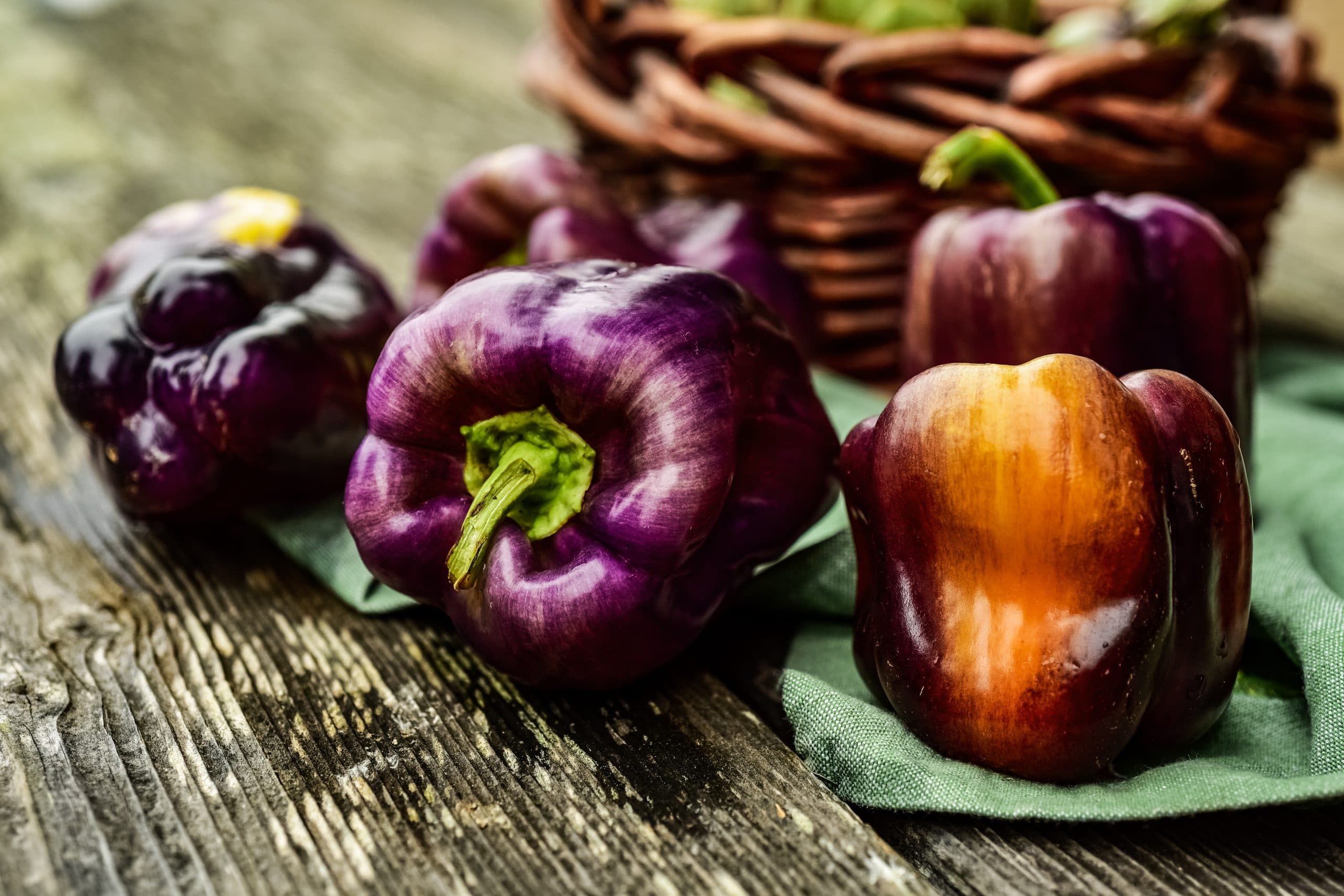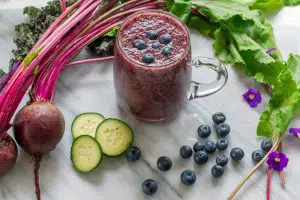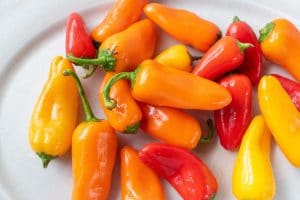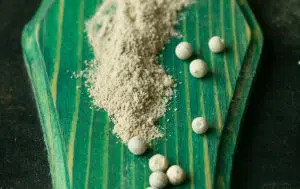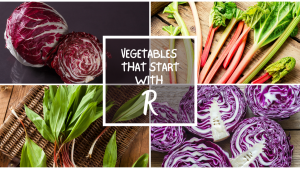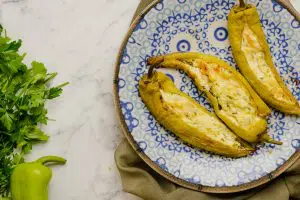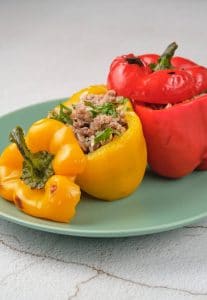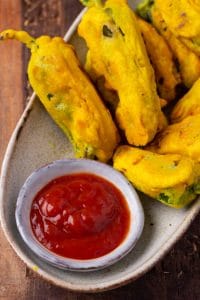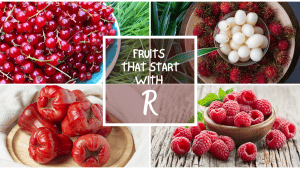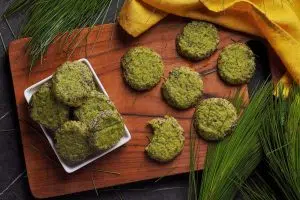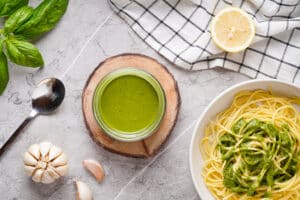All About Purple Peppers
Important Note: When you buy through our links, we may earn a commission. As an Amazon Associate we earn from qualifying purchases. Content, pricing, offers and availability are subject to change at any time - more info.
There are approximately twelve common types of purple peppers, and all of them belong to the Capsicum annuum family. They are generally grown as ornamental plants but you can also harvest them before they turn red, to serve on a plate. Purple peppers offer a taste range varying from sweet to spicy.
Are you captivated by the unique beauty of purple peppers? Do you want to learn more about purple peppers so that you can show them off in your garden or to entice your palate? Discover all there is to know about purple peppers and how they can spice up your garden- and taste buds!
- What Are Purple Peppers?
- Are Purple Peppers Edible?
- What Do Purple Peppers Taste Like?
- What Can You Do With Purple Peppers?
- The 12 Common Types Of Purple Peppers
- Are Purple Peppers Natural?
- Are Purple Peppers Good For You?
- Add A Dash of Purple to Your Life
What Are Purple Peppers?
Peppers are the edible fruits of the plants that belong to the Capsicum family. This family is quite diverse and includes sweet ‘bell’ peppers and hot and spicy ‘chili’ peppers. The majority of pepper plants are available in various colors including red, green, yellow, orange, white, and the beautiful, lesser-known purple variety.
Originating in Central and South America, peppers were soon introduced to the rest of the world by European explorers. They rapidly gained immense popularity. Purple peppers thrive in warm, sunny environments and moist soil. They can be grown outdoors, in a greenhouse, in small containers, or even in a bright spot inside your home.
Purple peppers can be divided into three categories:
- Sweet purple peppers: Enjoyed for their mild, sweet flavor.
- Hot purple peppers: Add a spicy kick to recipes.
- Ornamental purple peppers: Grown for decorative purposes in the house or garden.
Did you know?
- With most varieties, the pepper’s beautiful purple hue is the second-last stage of the ripening process, after which it typically turns red once it fully matures.
Most peppers are green during the first growth stage; therefore, green peppers are ‘unripe’ fruit. The pepper gradually develops into yellow or orange and then red when fully ripe. Some may turn white or purple before maturing to red.
- Unfortunately, most purple peppers will turn green once cooked.
Serve purple peppers fresh in salads, dips, and salsa to retain their distinctive color.
Are Purple Peppers Edible?
Do not be intimated by their exotic appearance. Purple peppers are not only edible but delicious too! Most pepper varieties are initially green and then they develop a deep purple before turning red once fully matured.
This means that you are eating a pepper during its second phase of growth. Similarly, you can eat green peppers, which are technically ‘unripe’, but are still perfectly okay to consume.
What Do Purple Peppers Taste Like?
Purple peppers range from sweet (purple bell peppers) to hot and spicy (purple cayenne peppers). Most purple peppers have a hollow cavity and the flesh has a crisp, juicy, and crunchy texture.
The Scoville Scale is used to measure the heat and spiciness of peppers, and it can range from 0 SHU (Scoville heat units) right up to 3,000,000 SHU (the hottest chili in the world, Pepper X).
What Can You Do With Purple Peppers?
Purple peppers are a brilliant addition to any garden or home. They can be used for decorative or culinary purposes. Either way, they will be a hot topic for discussions in the garden or around the dinner table!
Their unique, exotic appearance and pungent flavor will add depth to salsa, salads, dips, stir-fries, and sides. The larger peppers can be stuffed with mince, rice, and cheese. Hotter varieties of purple peppers will appeal to those who like a challenge.
The 12 Common Types Of Purple Peppers
There is a whole family of purple pepper varieties waiting to be discovered (and ready to challenge your taste buds!).
Bolivian Rainbow Hot Pepper
SHU: 30,000 to 50,000
Best for: Showing off in your garden or kitchen.
Born in Bolivia, you can compare these show-stopping peppers to Christmas lights – colorful, festive, and conical in shape. The stems and leaves are purple providing the perfect background to show off the dozens of small peppers that mature at different rates, resulting in a cascade of colors!
Their heat can be compared to cayenne or tabasco and they are about four to twelve times stronger than jalapenos. Bolivian Rainbow peppers are ornamental plants that can be grown indoors. The vibrant colors will add life to your salsa or salad.
Purple Bhut Jolokia Ghost Pepper
SHU: 800,000 to 1,300,00
Best for: Daredevils and the keen pepper plant collector.
This extremely rare firecracker was once regarded as the hottest in the world- approximately 300 times hotter than a jalapeno! The purple Bhut Jolokia is a ghost pepper variant that originates from Northeast India.
These peppers are long and wrinkly and they turn from a deep purple to red as they mature. The plant is tall and bushy with attractive purple flowers. Purple Bhut Jolokia has a surprisingly fruity flavor that evolves into an intense heat that builds up and lasts for 30-40 minutes. Expect watery eyes, a numb tongue, and shortness of breath!
Purple Cayenne Pepper
SHU: 30,000 to 50,000
Best for: Container gardening and flavorful culinary creations.
This is the most well-known purple pepper and one of the hottest cayenne varieties! It showcases stunning purple flowers and thin, dark-violet chilies. The purple cayenne pepper plant is small enough to grow in a container and will make an attractive addition to your home or yard.
Purple cayenne peppers may be hot, but they have incredible flavor. Finely chop the peppers and add them to dips, salsa, stir-fry, curry, or soup for a spicy kick and depth of flavor.
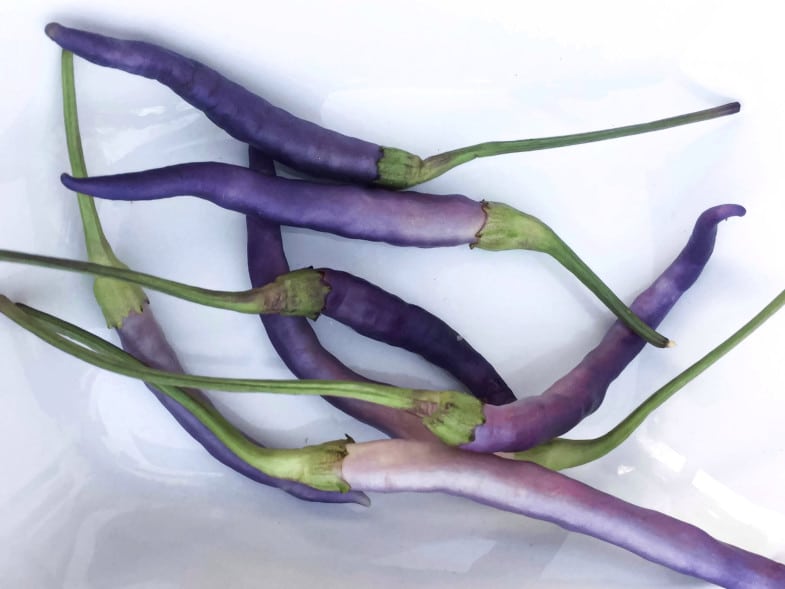
Purple Cluster Pepper
SHU: 5,000 to 30,000
Best for: Ornamental purposes.
Cluster pepper plants are grown for their ornamental value as the fruit looks stunning as it turns purple to red. The conical peppers grow upright, which makes this plant unique. Ornamental peppers are edible, but their flavor is not particularly complex.
Purple Bell Pepper
SHU: 0
Best for: Low-maintenance gardening and a variety of family-friendly dishes.
Purple bell peppers sit at the bottom of the Scoville scale, as they lack capsaicin (the compound that gives chili peppers their fiery kick). There are multiple varieties of purple bell peppers, including purple Holland, purple beauty, merlot, and tequila. These peppers are easy to grow, and they do well in a small garden or container.
Purple bell peppers add a deliciously sweet flavor and a crunchy texture to fresh or cooked dishes. Enjoy stuffed with mince and cheese, or chop and spread them over cooked veggies, salads, or pizza.
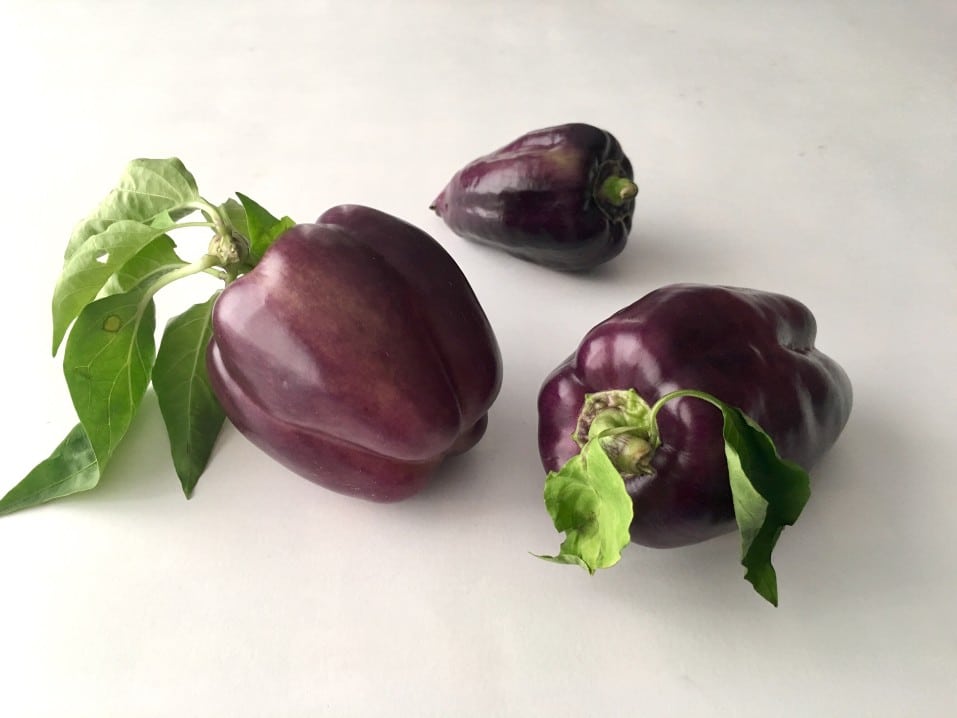
Mr. Purple Hot Pepper
SHU: 3,000 to 25,000
Best for: Mild spiciness and indoor planting.
Mr. Purple hot pepper is fantastic for a kitchen windowsill. It is small enough for a container and mild enough to quickly chop and spruce up your meals. The plant has green stems with pretty purple flowers. The peppers are ideal for making pickles and sauces.
Purple Jalapeno Pepper
SHU: 2,500 to 8,000
Best for: A sweet and spicy kick.
A firm favorite, purple jalapeno peppers strike the perfect balance of sweet and spicy. Their heat is tolerable and it won’t overpower the other flavors in a dish. You can roast, grill, sauté, or bake jalapenos for a variety of meals.
Purple jalapenos are also grown as ornamental plants and their size is ideal for gardening or landscaping purposes. The peppers go from green to purple and eventually turn red once they mature. Most jalapeno plants display all three colors at the same time.
Purple Marconi Pepper
SHU: 0
Best for: Their sweet and smoky flavor.
This is the rarest Marconi variant. These large Italian grilling peppers are sweet, firm, and crunchy. Thus, they are perfect for stuffing, as a pizza topping, in stir-fries or salads. Most people will welcome their 0 rating on the Scoville scale! The purple Marconi is substantially larger than most purple pepper plants and the fruit can grow 6 inches (15cm) long. It is better suited for outdoor gardening.
Purple Prince Pepper
SHU: 4,000 to 10,000
Best for: Decorative purposes in small homes.
Also known as pretty in purple due to its gorgeous purple fruit, leaves, and stems. While the purple prince plant may be small, growing just 2 feet (60cm) tall, it produces an impressive yield of crisp and spicy peppers.
As the plant matures, the peppers will turn orange and then crimson red. The purple prince is truly charming and compact enough for a kitchen or small balcony.
Murasaki Purple Pepper
SHU: 0 to 1,000
Best for: A rare ornamental gem. Enjoyed for its sweet, heatless taste.
These represent a rare and ancient Japanese heirloom. Murasaki purple peppers are sweet, crunchy, and extremely mild. They can be chopped for salsa, tossed into soup or salad, or stir-fried with other vegetables.
Murasaki purple pepper is valued as an ornamental plant with its robust, dark purple flowers and stems. The peppers are relatively large and conical with a thick, dark purple skin and green flesh. It is a hardy plant with abundant harvests.
Peruvian Purple Pepper
SHU: 12,000 to 30,000
Best for: Aesthetic and culinary purposes
This Peruvian beauty has pale purple flowers and dark violet leaves. It produces pungent, cherry-sized peppers that turn from violet to red. The Peruvian purple pepper is another compact plant that brings color to the home and fiery flavor to the plate. Win-win!
Purple Tiger Pepper
SHU: 4,000 to 9,000
Best for: A low maintenance, instant pop of color. Adding a touch of heat to meals.
A USA original, the purple tiger pepper is adored for its tri-colored foliage, which includes stunning shades of white, green, and purple. The peppers are purple and striped and eventually turn red if not harvested.
Also known as Trifetti, the purple tiger pepper plant spreads like a bush, but it can be restricted to a smaller size for pots and small gardens. The peppers have a medium heat and pleasant taste that compliments most dishes.
Are Purple Peppers Natural?
Yes, the beautiful and unique purple hue is ‘natural’ and part of the pepper’s ripening process.
It is nature’s way of signaling that the peppers are maturing. The pepper produces a high concentration of anthocyanins, which gives it a vibrant purple color so that it is more visible to animals, humans, and birds.
Are Purple Peppers Good For You?
Purple peppers have exceptional nutritional value. All varieties contain high levels of vitamins A, C, potassium, folic acid, and fiber. One of the most significant advantages is that they are incredibly low in calories! Peppers can be a great addition to a healthy diet.
Capsaicin (the compound that gives peppers their spicy kick) has been shown to increase metabolism, boost the immune system, and reduce inflammation.
Heatseekers should take caution: Capsaicin can irritate the eyes, skin, nose, and stomach. In large quantities, capsaicin may cause nausea, diarrhea, abdominal pain, and vomiting.
Anthocyanins (the compound that gives peppers their rich purple hue) are powerful antioxidants that help protect the cells from free radical damage that may cause illness and disease. The antioxidants may also support heart and brain health.
As the pepper ripens, the sugar content increases, and its vitamin C content doubles. Therefore, red peppers (purple peppers that have fully ripened) are the tastiest and highest in nutrition!
Purple peppers are low FODMAP and well-tolerated by most people when consumed in moderation. Allergic reactions are pretty rare.
Help! The Purple Peppers Are Too Hot to Handle
In this case, water won’t put out the fire. It may be the worst thing to reach for. Capsaicin is oil-based, so water will only spread the molecules throughout your mouth, making matters worse (think of mixing oil and water).
Instead, reach for milk-based products. They contain a protein called casein, which breaks down the capsaicin. Milk, ice cream, yogurt, or sour cream will do the trick. If you need to avoid dairy, acidic products such as lemonade, orange juice, or tomato-based foods/drinks will neutralize the capsaicin, which is alkaline.

Add A Dash of Purple to Your Life
With their unusual, eye-catching color, crunchy texture, and bold flavor, purple peppers are an absolute delight for the home gardener and keen chef! Mild and sweet, to fiery and practically unbearable – there is a purple pepper for everyone.
You’ll be amazed by the excitement that purple peppers bring from garden to plate!
